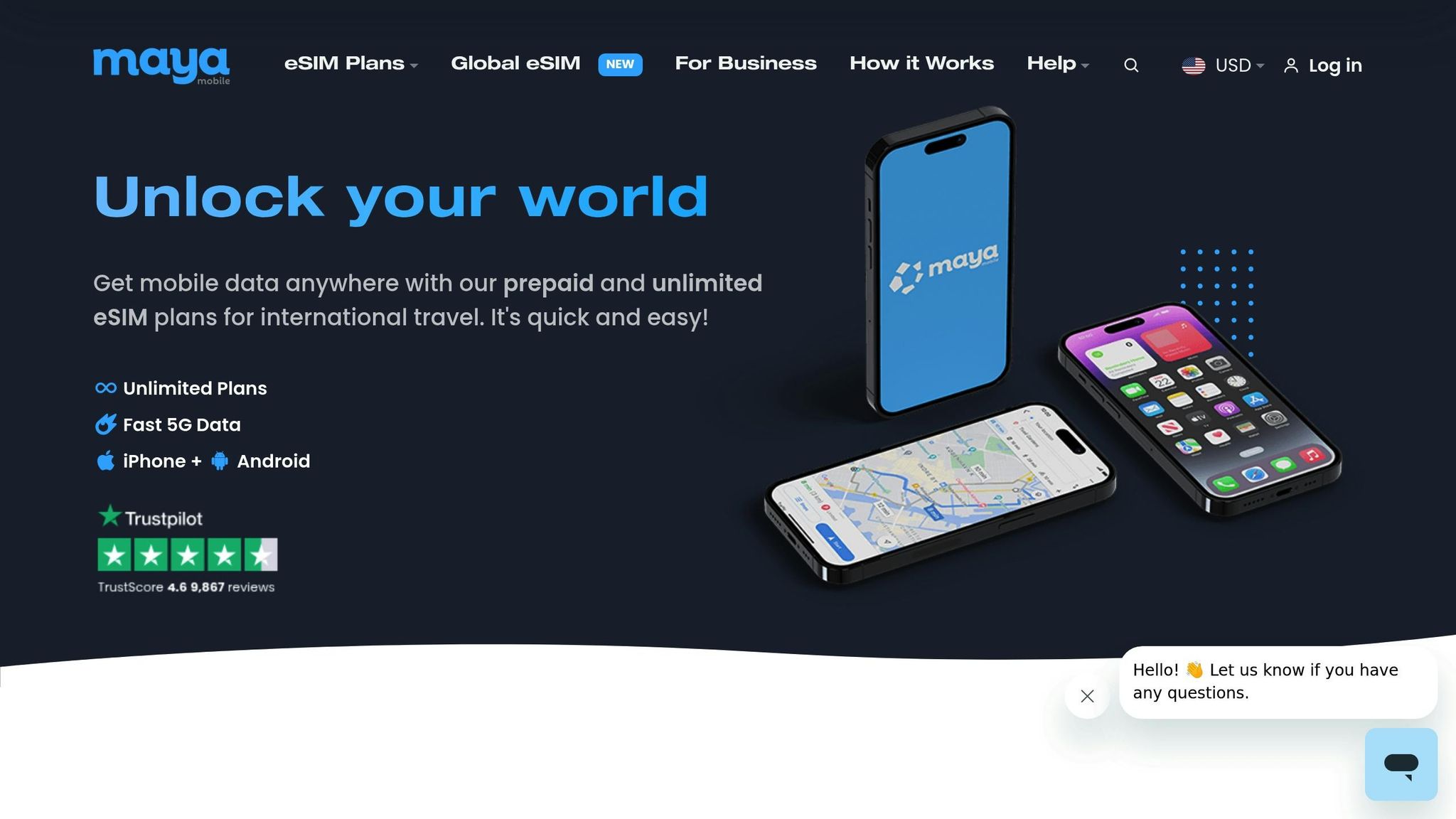Regional eSIM Plans: Managing Profiles Across Borders
https://www.zimconnections.com/regional-esim-plans-managing-profiles-across-borders/
 SHARE
SHARE
Travelling across borders no longer means dealing with physical SIM cards or high roaming charges. eSIMs offer a digital, hassle-free way to stay connected. Here’s what you need to know:
- Local eSIMs: Best for single-country trips. Affordable (£2.50–£40), with strong local network access. Ideal for longer stays but requires switching profiles when crossing borders.
- Regional eSIMs: Perfect for multi-country trips within a zone (e.g., Europe, Asia). Prices range from £15–£26 with shared data across destinations. Convenient for frequent border crossings but limited to specific regions.
- Global eSIMs: Designed for international travellers. Covers 190+ countries with plans starting at £1.50. Offers worldwide connectivity but at a higher cost.
Key benefits:
- Activate plans before travel.
- Save up to 50% compared to traditional roaming.
- Avoid the hassle of finding SIM cards abroad.
Quick Comparison:
| Plan Type | Use Case | Cost | Coverage | Key Limitation |
|---|---|---|---|---|
| Local | Single-country trips | £2.50–£40 | One country | Requires switching profiles at borders |
| Regional | Multi-country trips within zones | £15–£26 | Specific regions (e.g., Europe, Asia) | Limited to defined regions |
| Global | Frequent international travel | From £1.50 | 190+ countries | Higher costs per GB |
For UK travellers, regional eSIMs are ideal for nearby trips, while global plans suit those hopping continents. Providers like ZIM Connections simplify this with flexible options and instant activation. Stay connected wherever you go.
The Best Europe Travel eSIMs l Maya Mobile vs Airalo vs Nomad vs aloSIM Ranked

1. Regional eSIM Plans
Regional eSIM plans are perfect for travellers exploring multiple countries within the same area. Instead of juggling separate eSIMs for each destination, these plans provide uninterrupted connectivity across entire regions like Europe, Asia, Africa, North America, the Caribbean, Oceania, and the Middle East. Let’s dive into the details of coverage, pricing, data options, and flexibility to see why they’re a smart choice for multi-country trips.
Coverage
Regional eSIM plans are designed to offer connectivity across specific geographic zones, and their coverage can vary significantly between providers. Typically, plans are grouped by major regions. For instance, some providers offer coverage in Europe that spans 36 countries, including popular destinations like France, Germany, Italy, and Spain. In Asia, regional plans may include 13 countries such as Singapore, Thailand, Indonesia, Malaysia, and South Korea. Business travellers can also find plans that combine Europe, the USA, and other key hubs, covering up to 46 countries.
Beyond these, there are tailored options like North America (covering the United States, Canada, Mexico, and Puerto Rico), the Caribbean (25 countries including Jamaica, the Bahamas, and the Dominican Republic), and Africa (11 countries including South Africa, Egypt, Kenya, Morocco, and Nigeria). More focused plans are also available, such as those for the Balkans (11 countries including Greece, Croatia, Serbia, and Romania) or Oceania (Australia and New Zealand). In the Middle East, plans often cover 8 countries, including Oman, Jordan, Turkey, the UAE, Kuwait, Israel, and Egypt.
Pricing
When it comes to cost, regional eSIM plans in the UK market offer great value compared to buying multiple local eSIMs. Prices typically range from £15 to £26 for larger data packages, making them an affordable option for frequent travellers.
"Regional eSIM plans are designed to cover specific geographic zones… They’re cost-effective and optimised for performance within those regions." – BNESIM
The savings become even more apparent when visiting multiple countries. Regional plans often provide a lower cost per GB compared to global options and include larger data bundles. They’re also more economical than buying separate local eSIMs for each country – unless you’re only visiting one or two destinations in the region.
Data Options
Regional eSIMs come with a variety of data packages to suit different needs, ranging from 1GB to unlimited data. Durations typically span from 1 to 30 days, allowing travellers to choose a plan that matches the length of their trip rather than estimating usage for each country. Fixed data plans usually range between 1GB and 50GB, while unlimited options are also available for those with higher data demands. Some providers even offer auto-renewal features without requiring long-term commitments.
Unlike local eSIMs, where data is limited to a single country, regional plans let users share their data across all destinations within the covered region. This makes them a practical choice for travellers who want flexibility without the hassle of managing separate data plans.
Flexibility
For multi-country trips, regional eSIMs offer unmatched convenience. They allow travellers to adjust their plans on the go without losing connectivity. Instead of switching to a new local profile every time you cross a border, regional plans provide continuous coverage – a huge advantage for business travellers with unpredictable schedules.
Take ZIM Connections, for example. Their regional plans eliminate the need to manage multiple profiles while maintaining reliable 5G/4G performance. For journeys across three or more countries, regional eSIMs are a hassle-free and cost-effective solution compared to juggling multiple local plans.
2. Local eSIM Plans
Coverage
Local eSIM plans are tailored for use in a single country, providing connectivity and performance similar to what residents experience. As Airalo explains, "A local eSIM plan provides coverage within a single country (e.g., Germany)". These plans are optimised for domestic networks, ensuring reliable and high-quality service. Unlike regional options, which prioritise broader coverage, local plans focus on maximising performance within their specific country.
Pricing
When it comes to cost, local eSIM plans in the UK vary significantly. Budget options start at around £2.50, offering smaller data allowances, while premium plans with unlimited data can range between £30 and £40. This wide pricing range allows users to choose plans that best fit their budget and data needs.
Data Options
Local eSIM plans cater to a variety of data requirements, offering packages that range from as little as 1GB to unlimited data. Providers often include flexible options such as fixed data plans with specific durations or unlimited data bundles, sometimes combined with calls and texts. This variety ensures that both light and heavy data users can find a suitable plan.
Flexibility
While local eSIMs excel in providing strong domestic connectivity, they come with a drawback: crossing borders requires switching to a different profile. For frequent travellers or businesspeople with unpredictable itineraries, this can be a hassle. To address this, ZIM Connections offers an integrated solution. Their local plans can be seamlessly upgraded to regional or global coverage within their eSIM ecosystem. This means that if your travel plans expand beyond a single country, you can transition to broader coverage without losing connectivity or reconfiguring your settings. For those needing uninterrupted service across multiple countries, regional or global eSIM plans may be a more convenient alternative.
sbb-itb-273ea09
3. Global eSIM Plans
Coverage
Global eSIM plans are a game-changer for international travellers, offering connectivity in over 190 countries and regions. This makes them an excellent choice for business travellers and digital nomads who frequently cross borders. Unlike regional eSIM plans that focus on specific areas, global eSIMs truly deliver worldwide access.
One standout feature is their ability to switch networks automatically. As you move from one country to another, a global eSIM connects to the best available local network without requiring any manual adjustments. This ensures you have a strong signal the moment you arrive at your destination. For instance, a digital nomad hopping between Bali, Tokyo, and Berlin can rely on a single global eSIM plan to stay connected, all while managing data usage through a dedicated app. With such broad coverage, these plans are especially appealing when paired with their competitive pricing.
Pricing
Global eSIM plans are designed to be budget-friendly, with entry-level options starting at just £1.50. They cater to a variety of travel needs, offering small data packages for short trips, mid-sized plans for monthly use, and larger options that can last up to 60 days or more. Some plans even provide extended validity periods of up to 180 days, making them ideal for longer trips or moderate data use.
What makes global eSIMs particularly cost-effective is their partnership with local carriers. By working directly with these providers, eSIM companies can offer rates that are often cheaper than traditional roaming charges or international data plans from major network providers.
Data Options
Global eSIM plans are highly flexible when it comes to data. Whether you need a modest 1GB starter package or unlimited data for heavy usage, there are options to suit every traveller.
Most plans include a range of choices, from small allowances for short-term trips to larger packages for extended journeys. Some even offer daily unlimited data options. For those with unpredictable data needs, pay-as-you-go models are available, with rates starting as low as €0.55 per GB. These options are especially useful for travellers who prefer not to commit to a fixed data plan. Additionally, many plans support mobile hotspot functionality, though fair usage policies may apply.
Flexibility
One of the biggest advantages of global eSIM plans is their adaptability. They provide uninterrupted connectivity across borders, sparing you the hassle of buying new SIM cards or switching profiles every time you enter a new country. This is particularly valuable for frequent travellers.
For example, ZIM Connections offers global plans that integrate seamlessly into their eSIM ecosystem. Their coverage spans over 125 countries, providing 5G/4G connectivity and unlimited data options. Users can easily switch between local, regional, and global plans without needing complex configurations.
Global eSIMs also simplify travel by eliminating the need to research and purchase local SIM cards in each destination. They help you avoid the high roaming fees often charged by traditional carriers, saving both time and money. For business travellers and digital nomads, this translates to predictable costs and reliable connectivity.
When choosing a global eSIM, it’s important to check the coverage map to ensure all your destinations are included, as not all plans cover every country equally. Additionally, understanding terms related to data top-ups, hotspot usage, and fair usage policies will help you get the most out of your plan during your travels.
Advantages and Disadvantages
When it comes to selecting an eSIM plan, understanding the benefits and limitations of each type is essential. Whether you’re travelling across multiple countries, staying in one location for an extended period, or hopping between continents, each plan type offers unique perks and challenges. Let’s break it down.
Regional eSIM plans are a great middle ground for those travelling through several countries within a specific area. They’re particularly useful for short trips involving multiple destinations, as they allow you to share one pool of data across all covered countries. This eliminates the hassle of buying separate plans for each location and simplifies border crossings.
However, they’re not without drawbacks. Regional plans are confined to specific zones, so if your travel takes you beyond the covered area, you’ll need an alternative. Additionally, while they can be cost-efficient for short, multi-country trips, they might not be the best choice for longer stays in a single country.
For those focusing on one destination, Local eSIM plans shine. These plans connect directly to local networks, offering excellent coverage and faster speeds within the specific country. They’re often the best value for longer stays, whether you opt for a local eSIM or a traditional SIM card from a local provider. The downside? If you’re crossing borders, you’ll need to switch between eSIM profiles, which can be inconvenient for multi-country travel.
Finally, for frequent flyers and international travellers, Global eSIM plans are the go-to option. They provide coverage across a wide range of countries, making them ideal for business travellers or digital nomads who frequently move between continents. With one profile to manage, they offer unmatched simplicity. However, this convenience comes at a price – global plans are often more expensive than regional or local ones, and their data rates may not be the most competitive in specific countries.
| Plan Type | Best For | Advantages | Disadvantages |
|---|---|---|---|
| Regional | Multi-country trips within specific regions | Shared data across destinations, seamless border crossings, cost-efficient for regional travel | Limited to specific areas; not ideal for single-country stays |
| Local | Longer stays in one country | Best local network access, faster speeds, cost-effective for extended stays | Requires profile switching at borders; impractical for multi-country trips |
| Global | Frequent international travel | Coverage across multiple countries, single profile management, convenient for global travellers | Higher costs; less competitive local data rates |
The numbers also highlight the growing appeal of eSIMs. By 2027, the global eSIM market is projected to grow from £3.7 billion in 2023 to £12.8 billion. Meanwhile, in 2024, traditional roaming costs are expected to average £6.73 per GB, compared to £4.32 per GB for eSIM packages – a clear cost advantage.
When deciding on the right plan, think about your travel habits, how long you’ll be staying, and your data needs. ZIM Connections caters to these diverse requirements with its range of local, regional, and global eSIM plans. This flexibility ensures you can adjust your plan to suit your journey, making it easier to stay connected no matter where you go.
Conclusion
Choosing the right eSIM plan comes down to your travel habits and connectivity requirements. For UK travellers visiting multiple destinations within a region, regional eSIM plans strike a great balance by offering shared data allowances and uninterrupted connectivity without the hassle of switching profiles. If you’re staying in a single country, local eSIMs provide reliable network access and great value. Meanwhile, global plans are ideal for frequent travellers who hop across continents.
For European trips, regional plans are a smart choice. For single-country visits, local plans work best, and for international business travel, global plans offer unmatched convenience. When deciding, consider factors like data sharing, plan validity, voice service options, and coverage. Installing your eSIM before you leave ensures you’re connected the moment you land.
ZIM Connections simplifies this process by offering coverage in over 200 destinations, with local, regional, and global plans that activate instantly via their app. Their 24/7 customer support and flexible options make managing connectivity across borders effortless.
"With ZIM Connections, you can enjoy hassle-free connectivity, extensive coverage, cost-effective plans, and easy setup. Say goodbye to the stress of managing multiple SIM cards and hello to a smoother travel experience. Stay connected wherever your adventures take you with ZIM Connections."
FAQs
What are the key differences between regional, local, and global eSIM plans in terms of coverage and cost?
Regional eSIM plans are designed for travellers exploring multiple countries within a specific area. They offer more extensive coverage than local plans, which are restricted to a single country, but come at a slightly higher price. That said, they’re generally cheaper than global plans, which provide coverage across the world but are often the priciest option.
For trips within a region, these plans strike a good balance between affordability and convenience. They deliver faster data speeds by connecting to local networks and offer competitive rates per GB. On the other hand, global plans, while covering a broader range of destinations, might suffer from slower speeds or higher latency in certain areas. This makes them a better fit for travellers moving between continents or frequently changing regions.
Can I use a regional eSIM plan if I travel to countries outside the covered region?
Regional eSIM plans are tailored for use within a specific set of countries. However, some of these plans might still offer connectivity outside their designated region, provided roaming is enabled. To avoid unexpected charges, it’s crucial to review the terms of your eSIM plan and confirm whether roaming is supported and what costs might be involved.
If your travels take you beyond the covered region, opting for a global eSIM plan could be a smart choice. These plans offer seamless connectivity across multiple countries, helping you save both time and money while ensuring you remain connected no matter where your journey takes you.
How do I decide between a local, regional, or global eSIM plan for my travels?
Choosing the right eSIM plan largely depends on the details of your travel plans. If you’re taking a short trip to a single country, local plans are a great choice – they’re affordable and designed for limited use. On the other hand, regional plans are ideal if you’re travelling to multiple countries within a specific area, giving you the convenience of broader coverage. For those who frequently hop between countries, global plans offer seamless connectivity across many destinations, making them a reliable option for international travellers.
When selecting a plan, think about the coverage area, cost, and how simple it is to manage profiles as you cross borders. For instance, regional or global plans can save you the hassle of constantly switching profiles. Don’t forget to check if the plan is compatible with your device and whether it meets your data and connectivity needs while staying within your budget.










































































































































































































